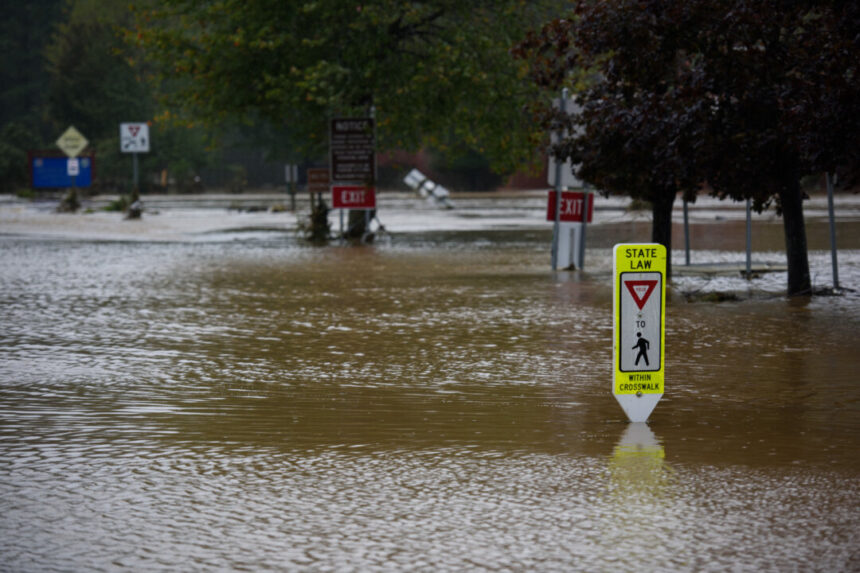The article discusses the aftermath of Hurricane Helene in western North Carolina, highlighting the unexpected devastation and the lack of preparedness among residents and the government. The storm caused significant damage, including flooding, destruction of homes, and loss of life. Despite the tragedy, the residents showed resilience and unity in the face of adversity, coming together to support each other in difficult times. The article also mentions the politicization of the disaster by some individuals and politicians, but emphasizes the stories of hope and cooperation that emerged from the community. The commercial districts still carry remnants of the ghostly atmosphere from the COVID era, with downed trees lining the roadways that once attracted 14 million annual visitors to witness the vibrant fall foliage. The loss of these trees raises concerns about the impact on the tourism economy, which generates $7.7 billion for the region. The devastation caused by Hurricane Helene has left Asheville’s River Arts District in ruins, with studio spaces stripped down to the studs. The question arises: where will the courage and resources come from to rebuild?
Beverly Ramsey reflects on her childhood memories in Chimney Rock and wonders how such places can be reconstructed. As she drives to T-Birds, a local bar turned donation center, she marvels at the outpouring of support from near and far. The community bands together to meet the immediate needs of those affected by the storm, showcasing resilience and self-reliance in the face of disaster.
Ramsey recounts the chaos and confusion that followed Helene’s impact, emphasizing the importance of community solidarity in the absence of outside assistance. She mourns the lives lost and the destruction wrought on local farms, acknowledging the long road to recovery ahead. Uncertainty looms over the future of businesses like hers, while the prospect of rebuilding cherished landmarks remains daunting.
As the cleanup efforts continue in the aftermath of the storm, the extent of the damage in the River Arts District is staggering. The once-vibrant hub of creativity now lies in ruins, symbolizing the challenges that lie ahead for the resilient community of Asheville. The future of the old structures, most of them former mills and factories built in the early 1900s, remains uncertain. What happens to a century-old foundation buried under 27 feet of water? Touring the district with Buttigieg on Oct. 17, North Carolina Gov. Roy Cooper expressed optimism, stating that the area would “bounce back” but likely “in a different way.”
As you drive east, uncertainty looms large. Bridges that were recently submerged under debris and buildings now stand empty, with 12 feet of sludge lining the roadsides for miles. Despite the desolate appearance, there are signs of life: earthmovers, bucket trucks, linemen restoring electrical lines, and water trucks delivering potable water. The landscape may seem post-apocalyptic, with Swannanoa and Lake Lure towns devastated by the floods.
The Lake House Restaurant, once bustling, now sees only a few patrons. Rodolfo and Jose Hernandez, part of Swadley’s Emergency Relief Team, have come to provide aid. They serve real food to work crews, bringing comfort in the form of barbecue, steak, ribs, turkey, and ham. The charitable efforts of Brent Swadley and his team bring hope to the community.
In the aftermath of the disaster, a network of kind-hearted individuals emerges: volunteers, relief teams, and local businesses stepping up to help. Amidst the challenges, a sense of unity and resilience prevails. As the region navigates recovery, frustrations arise, particularly with insurance companies denying flood damage claims.
Rebuilding lives and communities post-Helene is a complex process. The road ahead may be long and arduous, but the spirit of generosity and compassion sustains those affected. While uncertainties linger, the people of western North Carolina stand strong, supported by a network of caring individuals and organizations determined to help them through these trying times. Regarding the more sensational stories circulating online, like reports of FEMA workers being pursued by armed vigilantes, a spokesperson emphasized the importance of focusing on providing assistance to those affected by the recent disaster. The spokesperson acknowledged the challenges faced in the aftermath but encouraged people to register for aid and explore available resources.
One survivor, Kim Pierce, shared her harrowing experience of losing everything in the flood. Despite the devastation, she found moments of hope amidst the despair. Pierce recounted how her daughter had feared the worst when she couldn’t locate her after the flood, highlighting the emotional toll the disaster took on families.
The community grappled with the overwhelming task of rebuilding in the wake of such widespread destruction. Chris Trusz reflected on the extensive damage caused by the storm and the long road ahead for recovery. Despite the resilience of the town, many residents were considering leaving due to the scale of the devastation.
As recovery efforts continued, residents and business owners in Chimney Rock worked tirelessly to salvage what they could from the wreckage. The community rallied together with support from various organizations to aid in the cleanup and restoration process.
The article, originally published on RealClearInvestigations, captured the raw emotions and challenges faced by those impacted by the disaster. It serves as a reminder of the strength and unity displayed in times of crisis. Can you please rephrase that?
Source link





